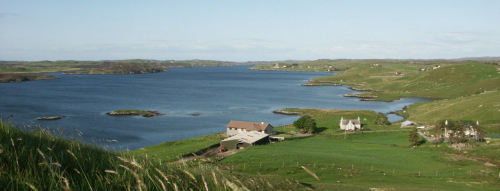Habost
Habost is said to be one of the oldest settlements in Park. The name is Scandinavian, the suffix “Bost” meaning a homestead or farm in Norwegian. Under the Highland clan system Habost was a tack and the various tacksmen surrounded themselves with small-holders on a year by year tenancy.
It is difficult to trace the names of all the Tacksmen that occupied Habost, but we know that in 1718 and 1726 Alex Mackenzie held the tenancy of the Tack. We also know that Angus Smith who was born in 1736 entered the Tack of Habost and Cleitir. Angus was probably a son of Murdo Smith who was tenant at Sheildinish in 1770.
Angus Smith was married to Barbara Macleod, Daughter of Donald Macleod, “Domhnuill Mac Iain Mhic Thorcuill”. Barbara’s brother, John Macleod, Calbecks, was a wealthy planter in Jamaica, and by the terms of his will Barbara was secured an annuity of £20.00 sterling, which was a considerable sum of money at that time. She was known as “Lady Habost”.
Habost Tack House was built of stone and lime walls and red roof tiles, fragments of which were found in the ground on the site of the farm house. When the site was cleared in order to use the stones in other buildings. It was felt locally that the red roof tiles might have been taken to Habost by the sea captain from one of his overseas voyagers.
Local tradition also associates the sea captain, who was obviously a relative of Barbara or her husband, with white slavery. It was alleged that he sailed away with a ship load of Island girls on the pretence of obtaining employment for them on the mainland and none of them were ever heard of again, except one Laxay girl who happened to be seen by two Lochs soldiers who were passing the house of a rich Indian Potentate where she was detained.
It seems likely that it was after Angus Smith that Allan Morrison became Tacksman of Habost. Local tradition refers to him as “Allan Mac a Mhinister”. It was said that Allan also had a brother that operated ships, possibly as captain. After Allan Morrison came the last tacksman at Habost, Duncan Maclennan, “Donnachadh Mae Dhomnuill ‘ic Raouill” who came from Ensay or Taransay in Harris.
After the tacksman system was discontinued and Habost was lotted under the crofting system of land tenure, Duncan Maclennan continued to live on croft 13 where the Tack House was sited. Local tradition maintains that Duncan Maclennan’s Tack embraced what are now crofts 9, 10, 11,12 and 13 and that these crofts may not have been created as early as the other Habost crofts. Also it is possible that the smallest holders land may have been in the middle of the village, which suggests that perhaps there may have been a tacksman at each end of the village as there was at Kershader.
Booklet available.
Habost genealogy on Hebridean Connections.
